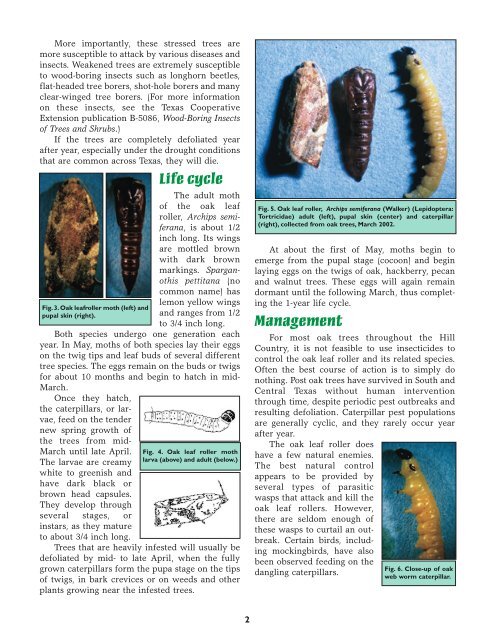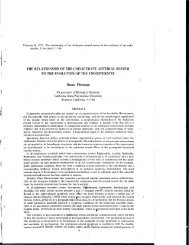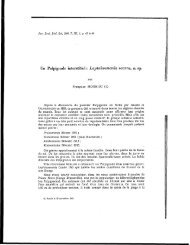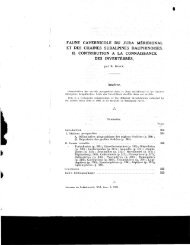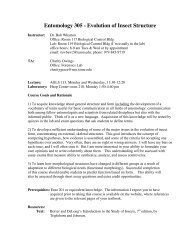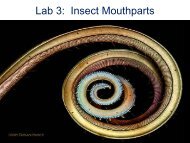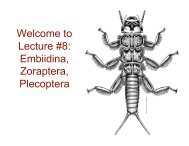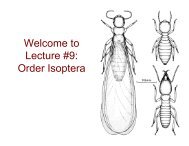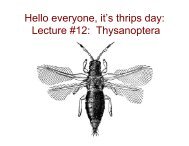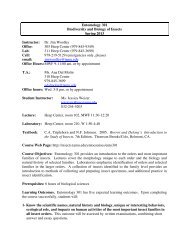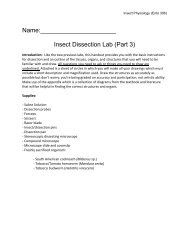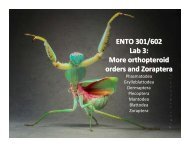Oak Leaf Roller and Springtime Defoliation of Live Oak Trees
Oak Leaf Roller and Springtime Defoliation of Live Oak Trees
Oak Leaf Roller and Springtime Defoliation of Live Oak Trees
- No tags were found...
You also want an ePaper? Increase the reach of your titles
YUMPU automatically turns print PDFs into web optimized ePapers that Google loves.
More importantly, these stressed trees aremore susceptible to attack by various diseases <strong>and</strong>insects. Weakened trees are extremely susceptibleto wood-boring insects such as longhorn beetles,flat-headed tree borers, shot-hole borers <strong>and</strong> manyclear-winged tree borers. (For more informationon these insects, see the Texas CooperativeExtension publication B-5086, Wood-Boring Insects<strong>of</strong> <strong>Trees</strong> <strong>and</strong> Shrubs.)If the trees are completely defoliated yearafter year, especially under the drought conditionsthat are common across Texas, they will die.Life cycleThe adult moth<strong>of</strong> the oak leafroller, Archips semiferana,is about 1/2inch long. Its wingsare mottled brownwith dark brownmarkings. Sparganothispettitana (nocommon name) haslemon yellow wings<strong>and</strong> ranges from 1/2to 3/4 inch long.Both species undergo one generation eachFig. 3. <strong>Oak</strong> leafroller moth (left) <strong>and</strong>pupal skin (right).year. In May, moths <strong>of</strong> both species lay their eggson the twig tips <strong>and</strong> leaf buds <strong>of</strong> several differenttree species. The eggs remain on the buds or twigsfor about 10 months <strong>and</strong> begin to hatch in mid-March.Once they hatch,the caterpillars, or larvae,feed on the tendernew spring growth <strong>of</strong>the trees from mid-March until late April.The larvae are creamywhite to greenish <strong>and</strong>have dark black orbrown head capsules.They develop throughseveral stages, orinstars, as they matureto about 3/4 inch long.Fig. 4. <strong>Oak</strong> leaf roller mothlarva (above) <strong>and</strong> adult (below.)<strong>Trees</strong> that are heavily infested will usually bedefoliated by mid- to late April, when the fullygrown caterpillars form the pupa stage on the tips<strong>of</strong> twigs, in bark crevices or on weeds <strong>and</strong> otherplants growing near the infested trees.Fig. 5. <strong>Oak</strong> leaf roller, Archips semiferana (Walker) (Lepidoptera:Tortricidae) adult (left), pupal skin (center) <strong>and</strong> caterpillar(right), collected from oak trees, March 2002.At about the first <strong>of</strong> May, moths begin toemerge from the pupal stage (cocoon) <strong>and</strong> beginlaying eggs on the twigs <strong>of</strong> oak, hackberry, pecan<strong>and</strong> walnut trees. These eggs will again remaindormant until the following March, thus completingthe 1-year life cycle.ManagementFor most oak trees throughout the HillCountry, it is not feasible to use insecticides tocontrol the oak leaf roller <strong>and</strong> its related species.Often the best course <strong>of</strong> action is to simply donothing. Post oak trees have survived in South <strong>and</strong>Central Texas without human interventionthrough time, despite periodic pest outbreaks <strong>and</strong>resulting defoliation. Caterpillar pest populationsare generally cyclic, <strong>and</strong> they rarely occur yearafter year.The oak leaf roller doeshave a few natural enemies.The best natural controlappears to be provided byseveral types <strong>of</strong> parasiticwasps that attack <strong>and</strong> kill theoak leaf rollers. However,there are seldom enough <strong>of</strong>these wasps to curtail an outbreak.Certain birds, includingmockingbirds, have alsobeen observed feeding on thedangling caterpillars.Fig. 6. Close-up <strong>of</strong> oakweb worm caterpillar.2


